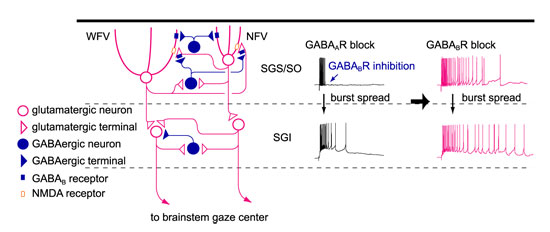Katsuyuki Kaneda,1,2 Penphimon Phongphanphanee,1,2 Tomoko Katoh,1 Kaoru Isa,1,3 Yuchio Yanagawa,4 Kunihiko Obata,5 and Tadashi Isa.1,2,3 Regulation of Burst Activity through Presynaptic and Postsynaptic GABAB Receptors in Mouse Superior Colliculus. The Journal of Neuroscience, 23 Jan 2008; 28 (4) 816-827
In slice preparations, electrical stimulation of the superficial gray layer (SGS) of the superior colliculus (SC) induces EPSC bursts in neurons in the intermediate gray layer (SGI) when GABAA receptor (GABAAR)-mediated inhibition is reduced. This preparation has been used as a model system to study signal processing involved in execution of short-latency orienting responses to visual stimuli such as saccadic eye movements. In the present study, we investigated the role of GABAB receptors (GABABRs) in modulating signal transmission in the above pathway with whole-cell patch-clamp recordings in SC slices obtained from GAD67-GFP knock-in mice. Perfusion of the slice with the GABABR antagonist CGP52432 (CGP) greatly prolonged the duration of the EPSC bursts. Local application of CGP to the SGS but not to the SGI produced similar effects. Because SGS stimulation elicited bursts in GABAergic neurons in the SGS when GABAARs were blocked, these results suggest that GABA released after bursts activates GABABRs in the SGS, leading to reduced burst duration. We found both postsynaptic and presynaptic actions of GABABRs in the SGS; activation of postsynaptic GABABRs induced outward currents in narrow-field vertical cells, whereas it caused shunting inhibition in distal dendrites in wide-field vertical cells. On the other hand, activation of presynaptic GABABRs suppressed excitatory synaptic transmissions to non-GABAergic neurons in the SGS. These results indicate that synaptically released GABA can activate both presynaptic and postsynaptic GABABRs in the SGS and limit the duration of burst responses in the SC local circuit.

Schematic of local circuit underlying GABABR-mediated regulation of bursts in the SC. Postsynaptic GABABRs expressed both in NFV and WFV cells and presynaptic GABABRs located on glutamatergic synaptic terminals in the SGS are activated by synaptically released GABA during bursts of SGS GABAergic neurons. Hyperpolarization in NFV cells, shunting inhibition in WFV cells, and reduction of glutamate release may contribute to the limitation of burst duration. When GABABRs are blocked, burst duration in the SGS may be prolonged in an NMDAR-dependent manner, and then, the prolonged burst may spread to the SGI. Thus the burst duration of the SGI may also be prolonged. Note that the localization of the receptors and synaptic connections essential to explain the present results are depicted and other components such as AMPA ⁄ Kainate receptors and GABAARs are not drawn for clarity.